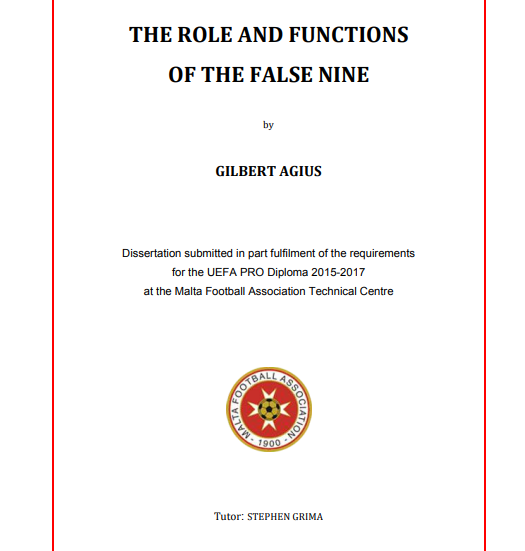INTRODUCTION
Football is a vast and complex subject and it is not easy to focus on a single topic for a dissertation.
I thoroughly discussed the selection of my topic and shared ideas with several of
my friends in the football field, but I do have to say that the main inspiration and final decision
came from the passion that I have for this magnificent sport buried within me.
Football has
been my biggest love since childhood. I was always fascinated and enthusiastic about anything associated with it.
I knew all the players’ profiles by heart and I had numerous idols.
However, my all-time favourite players have always been the talented and creative strikers,
Francesco Totti and Lionel Messi.
These two players created the spark for my dissertation
and they were the reason why I decided to focus on one particular position of play, the
‘False9’.
The ‘false 9’ is a decoy centre forward in a team deliberately set up without a dedicated striker1
.
The lone striker then drops deep, often as deep as the midfield line.
He comes so deep
that he leaves the central defenders with no one to mark.
The central defenders would usually feed off the striker, judging his positioning and adjusting their movements according to the
centre forward’s actions - however without one they become redundant.
The typical ‘false 9’ is not the big hammering attacker, but rather a finesse-oriented player
who likes to check back to midfield to participate in possession instead of waiting for a long
direct ball.
The player also prefers to receive the ball when played on the ground rather than
being involved in physical aerial duels with stronger defenders.
Players utilised in this position are usually technical players, equally gifted in the areas of dribbling, passing and finishing.
They should be capable of receiving the ball amidst the minefield of holding midfielders
and centre-backs with ease, then turning and running at defenders, or feeding an intricate
through ball to a winger or midfielder who then capitalises from the spaces left by the same
movement from the ‘false 9’.
midfielders who are capable of retaining possession and organising the game from the centre part of the field and also able to find the
‘false 9’ when he is roaming in pockets of space between the lines.
When retreating deep in
the middle third, the ‘false 9’ creates an overload in the middle area which facilitates ball retention and helps the team to remain in command of the game.
Teams using this system normally seem to have a numerical advantage over their opponents in every area of the field
of play.
Some teams have also managed to convert players’ roles from midfielders to defenders and from central strikers to wingers to compliment the functions of the ‘false 9’ within
the team.
Others have used technically able midfielders as fullbacks to facilitate build-up
from the back - another important common factor for most teams playing with the ‘false 9’.
This rotation of players is synonymous with a brand of football known as ‘total football’ and is
necessary for the success of the ‘false 9’.
‘Total football’ is the label given to an influential
tactical theory of association football in which any outfield player can take over the role of
any other player in a team.
It creates a fluid system whereby no outfield player is fixed in a
predetermined role and any player can successively play as an attacker, a midfielder or a
defender.
The only player who must stay in a specified position is the goalkeeper – and nowadays, even goalkeepers are being involved in the build-up.
In ‘total football’, a player who moves out of position is replaced by another player from the
same team, thus retaining the team's intended organisational structure.
The formation works
best with technically adept central midfielders who can control the game by dominating possession.
That dominance of the ball helps the side to keep play in the offensive half, which
creates the conditions in which the ‘false 9’ can thrive.
This system usually allows the team to
control the game with ball retention because the ‘false 9’ frequently operates as an additional
central midfielder, linking up play and helping to outnumber opposing teams in central areas.
This brand of football was made famous by the Netherlands national team in the 1974 FIFA
World Cup finals in West Germany.
In my opinion, the ‘false 9’ and ‘total football’ system cannot exist without each other – they
are interdependent.
To dominate possession one needs to have rotations between players
and players capable of playing in any role.
This relentless rhythm of possession is perhaps
the true centre of the teams’ philosophy and identity of most of the teams playing with the
‘false 9’.
The system is built around circulating the ball and using rotations within the entire
team and is emblematic of the unselfish, team-oriented outlook.
It is not a coincidence that many of the teams made famous for utilising the ‘false 9’ have incorporated the ‘total football’ system into their play - they need to have the same philosophy
to reach their targets.
Tags:
BOOK PDF

